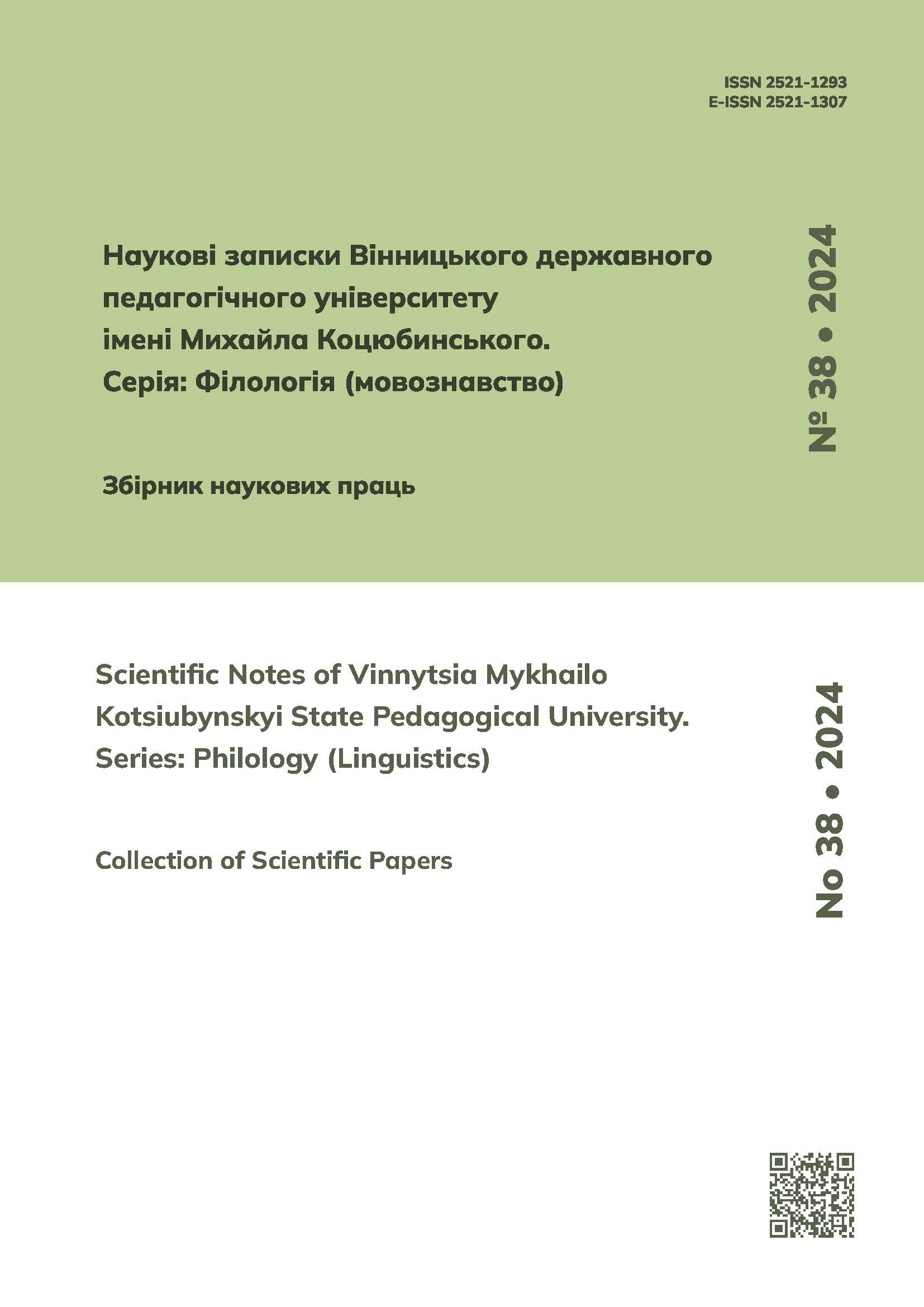Recontextualization in student slang translation
https://doi.org/10.31652/2521-1307-2024-38-11Published 2024-08-14
Keywords
- context, recontextualization, student slang, lexical and stylistic peculiarities, translation technique
Copyright (c) 2024 Liudmyla Kovalchuk, Iryna Lesyk, Yuliia Litkovych

This work is licensed under a Creative Commons Attribution 4.0 International License.
How to Cite
Abstract
Student slang as a secondary communication system is used by students exclusively in the context of informal conversation, since slang units cannot be used appropriately without knowing specific university terminology. The difficulty of translating such profanity is caused by the need for recontextualization – the translator's reconstruction of the source and target text contexts. The study of student slang words, in particular the techniques of translating them from English into Ukrainian, is relevant due to the dynamic nature of student slang, as well as the expansion of the boundaries of contemporary academic mobility of students. The purpose of the article is to determine the peculiarities of using the recontextualization strategy in the main techniques of translating student slang from English into Ukrainian. The integrated study of recontextualization in student slang translation involved the application of the following methods: the method of continuous sampling (for assembling slang units from student web-blogs), the method of descriptive observation (for defining possible techniques of translating student slang), methods of analysis and synthesis (for singling out lexical and stylistic peculiarities of student slang translation and formulation of conclusions). Results. Within the framework of sociocognitive approach, context is considered to be a special mental construct generated by participants in their episodic memory in the course of communicative interaction. The relevant constituents of the unique, subjective and dynamic context model include the sender and receiver of the message, their relationship, personal (situational) and sociocultural knowledge, evaluations and emotions, place and time of communication. A translator as a mediator of communicative interaction between the sender and the receiver of the message, also constructs a context model. Effective translation activity is possible only if the peculiarities of the context models of both the sender and the receiver of the message are taken into account. That is why the translator's context model is formed by incorporating the context models of both communicative partners into an integrated context model. Recontextualization as a linguistic and cognitive operation is aimed at reconstructing a communicative situation in the conceptual coordinates of communicative partners. Recontextualization in translation is a comprehensive translation strategy that affects all structural and communicative levels of the text and is used to adapt the translated text to the conditions acceptable in the target environment and the pragmatics of bilingual interaction. The strategy of recontextualization in student slang translation includes several stages: reconstructing the integrated context model that will resonate with the usual, everyday conditions of student life; domesticating the source text through analogy and specification; using appropriate translation techniques and transformations to reproduce the meaning of student slang in the target language. A comprehensive analysis of the illustrative material proved that the strategy of recontextualization involves such most frequent techniques of translating student slang as the search for appropriate equivalents in the target language, descriptive translation, explication and calquing. The highlighting stylistic features of translating student slang include metaphor, metonymy and antonomasia. The stylistic load of student slang often causes translation difficulties, since the strategy of recontextualization requires the involvement of a wide range of not only situational background, but also encyclopaedic knowledge. Originality. The article presents the attempt of making a deep insight into the application of the recontextualization strategy in translating student slang from English into Ukrainian. Conclusion. The results of the study prove that student slang is a multifaceted and emotionally coloured linguistic phenomenon that serves not only as a means of communication but also as a kind of sypher encoded in a mosaic of words and phrases. The strategy of recontextualization as a multi-stage linguistic and cognitive operation is focused on the reconstruction of the communicative situation by the translator in order to adapt the target text and adequately translate slang units. It is proved that the main techniques of translating student slang from English into Ukrainian are the search for appropriate equivalents in the target language, descriptive translation, explication and calquing. Metaphor, metonymy and antonomasia are the most effective and frequent stylistic means aimed at fulfilling the pragmatic function of slang units. We consider the study of possible ways of translating student abbreviations and phraseological units from English into Ukrainian to be much promising.
Downloads
References
- Ковальчук, Л. (2017). Контекст та контекстуальність у сучасному англомовному дискурсі: дис. ... кандидата філол. наук: 10.01.04, Запоріжжя, 231 с.
- Паровознюк, Р. (2018). Реконтекстуалізація в перекладацькому аналізі медичного тексту. Актуальні питання гуманітарних наук: міжвузівський збірник наукових праць молодих вчених Дрогобицького державного педагогічного університету імені Івана Франка. Серія: Мовознавство. Літературознавство, Дрогобич: Видавничий дім «Гельветика», Вип. 21, т. 2. 53-57.
- Селіванова, О. О. (2010). Лінгвістична енциклопедія, Полтава: Довкілля-К, 844 с.
- Altahmazi, T. (2020). Creating realities across languages and modalities: Multimodal recontextualization in the translation of online news reports. Discourse, Context & Media. Elsevier, Volume 35. https://doi.org/10.1016/j.dcm.2020.100390 DOI: https://doi.org/10.1016/j.dcm.2020.100390
- Baker, M. (2006). Contextualization in translator- and interpreter- mediated events. Journal of Pragmatics. Elsevier, Volume 38, Issue 3, P. 321-337. https://doi.org/10.1016/j.pragma.2005.04.010 DOI: https://doi.org/10.1016/j.pragma.2005.04.010
- Dijk, T. A. van. (2008). Discourse and Context: A Sociocognitive Approach, New York: Cambridge University Press, 266 p. https://doi.org/10.1017/CBO9780511481499 DOI: https://doi.org/10.1017/CBO9780511481499
- Greenall, A. & Løfaldli, E. (2019). Translation and Adaptation as Recontextualization: The Case of the Snowman. Adaptation. Special Issue: Intersemiotic Translation as Adaptation, Oxford University Press, Volume 13, Issue 3. P. 199-205. https://doi.org/10.1093/adaptation/apz002 DOI: https://doi.org/10.1093/adaptation/apz002





